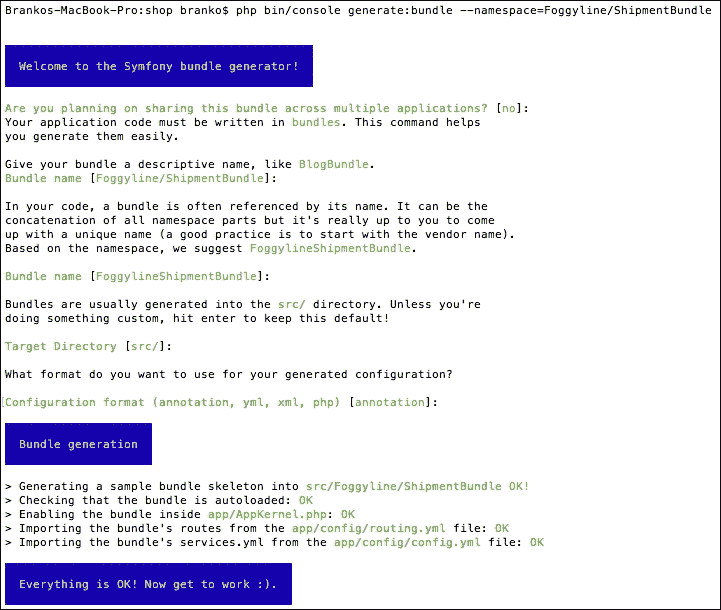- PHP7 模块化编程

PHP 构建发货模块详解
发货模块与payment模块一起,为我们网店的进一步销售功能提供了基础。当我们到达即将到来的sales模块的结账流程时,它将使我们能够选择发货方式。与payment类似,shipment可以是静态的,也可以是动态的。静态可能意味着一个固定的定价值,甚至是通过一些简单条件计算出的定价值,而动态通常意味着与外部 API 服务的连接。
在本章中,我们将接触这两种类型的基础,并了解如何建立实现shipment模块的基本结构。
在本章中,我们将介绍shipment模块的以下主题:
第 4 章、模块化网店 App需求规范中定义的应用需求,并未给出我们需要实施哪种类型的发货的任何细节。因此,在本章中,我们将开发两种装运方法:动态费率装运和固定费率装运。动态费率装运用作将装运方法连接到实际装运处理器(如 UPS、FedEx 等)的一种方式。但是,它实际上不会连接到任何外部 API。
理想情况下,我们希望通过类似于以下内容的接口完成此操作:
namespace Foggyline\SalesBundle\Interface;
interface Shipment
{
function getInfo($street, $city, $country, $postcode, $amount, $qty);
function process($street, $city, $country, $postcode, $amount, $qty);
}然后可以使用getInfo方法获取给定订单信息的可用交付选项,而处理方法随后将处理所选交付选项。例如,在动态费率装运方法下,我们可能会使用 API 返回“当天交付($9.99)”、=和“标准交付($4.99)”作为交付选项。
有了这样一个装运接口,就需要有SalesBundle模块,而我们还没有开发。因此,我们将继续使用我们的装运方法,使用 Symfony 控制器处理过程方法,使用服务处理getInfo方法。
类似地,正如我们在上一章中对付款方法所做的那样,我们将通过标记的 Symfony 服务公开我们的getInfo方法。我们将用于装运方式的标签为shipment_method。稍后,在签出过程中,SalesBundle模块将获取所有标记为shipment_method的服务,并在内部使用它们来列出可用的装运方法。
我们正在相反方向构建模块。也就是说,我们在了解SalesBundle模块之前就开始构建它,这是唯一一个使用它的模块。考虑到这一点,shipment模块对任何其他模块都没有牢固的依赖关系。然而,首先构建SalesBundle模块,然后公开shipment模块可能使用的几个接口可能会更方便。
我们将首先创建一个名为Foggyline\ShipmentBundle的新模块。我们将在控制台的帮助下运行以下命令:
php bin/console generate:bundle --namespace=Foggyline/ShipmentBundle
该命令触发了一个交互过程,该过程向我们提出了几个问题,如下所示:

完成后,将自动修改文件app/AppKernel.php和app/config/routing.yml。AppKernel类的registerBundles方法已添加到$bundles数组下的以下行:
new Foggyline\PaymentBundle\FoggylineShipmentBundle(),routing.yml文件已更新为以下条目:
foggyline_payment:
resource: "@FoggylineShipmentBundle/Resources/config/routing.xml"
prefix: /为了避免与核心应用程序代码冲突,我们需要将prefix: /更改为prefix: /shipment/。
创建统一费率发货服务
统一费率装运服务将提供sales模块将用于其检验过程的固定装运方法。它的作用是提供装运方法标签、代码、交付选项和处理 URL。
我们首先在src/Foggyline/ShipmentBundle/Resources/config/services.xml文件的 services 元素下定义以下服务:
<service id="foggyline_shipment.dynamicrate_shipment"class="Foggyline\ShipmentBundle\Service\DynamicRateShipment">
<argument type="service" id="router"/>
<tag name="shipment_method"/>
</service>此service只接受一个参数:router。tagname值被设置为shipment_method,因为我们的SalesBundle模块将根据分配给服务的shipment_method标签寻找装运方法。
我们现在将在src/Foggyline/ShipmentBundle/Service/FlatRateShipment.php文件中创建实际的service类,如下所示:
namespace Foggyline\ShipmentBundle\Service;
class FlatRateShipment
{
private $router;
public function __construct(
\Symfony\Bundle\FrameworkBundle\Routing\Router $router
)
{
$this->router = $router;
}
public function getInfo($street, $city, $country, $postcode, $amount, $qty)
{
return array(
'shipment' => array(
'title' =>'Foggyline FlatRate Shipment',
'code' =>'flat_rate',
'delivery_options' => array(
'title' =>'Fixed',
'code' =>'fixed',
'price' => 9.99
),
'url_process' => $this->router->generate('foggyline_shipment_flat_rate_process'),
)
;
}
}getInfo方法将为我们未来的SalesBundle模块提供必要的信息,以便它构建检验过程的shipment步骤。它接受一系列参数:$street、$city、$country、$postcode、$amount和$qty。我们可以认为这些是统一装运接口的一部分。delivery_options在本例中,返回单个固定值。url_process是我们将插入所选装运方式的 URL。我们未来的SalesBundle模块将只在这个 URL 上做一个 AJAX 帖子,期望 JSON 响应是成功还是错误,这与我们想象的支付方式非常相似。
创建统一费率发货控制器和路线
我们通过向src/Foggyline/ShipmentBundle/Resources/config/routing.xml文件添加以下路由定义来编辑src/Foggyline/ShipmentBundle/Resources/config/routing.xml文件:
<route id="foggyline_shipment_flat_rate_process"path="/flat_rate/process">
<default key="_controller">FoggylineShipmentBundle:FlatRate:process
</default>
</route>然后我们创建一个src/Foggyline/ShipmentBundle/Controller/FlatRateController.php。文件内容如下:
namespace Foggyline\ShipmentBundle\Controller;
use Symfony\Component\HttpFoundation\JsonResponse;
use Symfony\Component\HttpFoundation\Request;
use Symfony\Bundle\FrameworkBundle\Controller\Controller;
class FlatRateController extends Controller
{
public function processAction(Request $request)
{
// Simulating some transaction id, if any
$transaction = md5(time() . uniqid());
return new JsonResponse(array(
'success' => $transaction
));
}
}我们现在应该能够访问 URL,如/app_dev.php/shipment/flat_rate/process,并查看processAction的输出。这里给出的实现是虚拟的。我们需要知道的是,sales模块将在其签出过程中,通过shipment_method标记服务的getInfo方法提供任何可能的delivery_options。也就是说,结帐过程应该显示固定费率装运作为一个选项。签出的行为将被编码,这样,如果未选择shipment方法,它将阻止签出过程进一步进行。当我们进入SalesBundle模块时,我们将进一步讨论这个问题。
创建动态费率支付服务
除了固定费率装运方法之外,让我们继续定义另一种动态装运,称为动态费率。
我们首先在src/Foggyline/ShipmentBundle/Resources/config/services.xml文件的services元素下定义以下服务:
<service id="foggyline_shipment.dynamicrate_shipment"class="Foggyline\ShipmentBundle\Service\DynamicRateShipment">
<argument type="service" id="router"/>
<tag name="shipment_method"/>
</service>这里定义的service只接受一个router参数。tag name属性与统一费率装运服务相同。
然后我们将创建src/Foggyline/ShipmentBundle/Service/DynamicRateShipment.php文件,内容如下:
namespace Foggyline\ShipmentBundle\Service;
class DynamicRateShipment
{
private $router;
public function __construct(
\Symfony\Bundle\FrameworkBundle\Routing\Router $router
)
{
$this->router = $router;
}
public function getInfo($street, $city, $country, $postcode, $amount, $qty)
{
return array(
'shipment' => array(
'title' =>'Foggyline DynamicRate Shipment',
'code' =>'dynamic_rate_shipment',
'delivery_options' => $this->getDeliveryOptions($street, $city, $country, $postcode, $amount, $qty),
'url_process' => $this->router->generate('foggyline_shipment_dynamic_rate_process'),
)
);
}
public function getDeliveryOptions($street, $city, $country, $postcode, $amount, $qty)
{
// Imagine we are hitting the API with: $street, $city, $country, $postcode, $amount, $qty
return array(
array(
'title' =>'Same day delivery',
'code' =>'dynamic_rate_sdd',
'price' => 9.99
),
array(
'title' =>'Standard delivery',
'code' =>'dynamic_rate_sd',
'price' => 4.99
),
);
}
}与固定费率装运不同,getInfo方法的delivery_options键由getDeliveryOptions方法的响应构成。该方法是服务内部的,不被认为是公开的,也不被看作是接口的一部分。我们可以很容易地想象在其中进行一些 API 调用,以便为我们的动态装运方法获取计算出的费率。
创建动态费率发货控制器和路线
一旦动态费率装运服务到位,我们可以继续为其创建必要的路线。我们将首先在src/Foggyline/ShipmentBundle/Resources/config/routing.xml文件中添加以下路由定义:
<route id="foggyline_shipment_dynamic_rate_process" path="/dynamic_rate/process">
<default key="_controller">FoggylineShipmentBundle:DynamicRate:process
</default>
</route>然后我们将创建src/Foggyline/ShipmentBundle/Controller/DynamicRateController.php文件,内容如下:
namespace Foggyline\ShipmentBundle\Controller;
use Foggyline\ShipmentBundle\Entity\DynamicRate;
use Symfony\Component\HttpFoundation\JsonResponse;
use Symfony\Component\HttpFoundation\Request;
use Symfony\Bundle\FrameworkBundle\Controller\Controller;
use Symfony\Component\Form\Extension\Core\Type\ChoiceType;
class DynamicRateController extends Controller
{
public function processAction(Request $request)
{
// Just a dummy string, simulating some transaction id
$transaction = md5(time() . uniqid());
if ($transaction) {
return new JsonResponse(array(
'success' => $transaction
));
}
return new JsonResponse(array(
'error' =>'Error occurred while processing DynamicRate shipment.'
));
}
}与统一费率装运类似,这里我们添加了一个简单的流程和方法的虚拟实现。传入的$request应该包含与服务getInfo方法相同的信息,也就是说,它应该有以下可用参数:$street、$city、$country、$postcode、$amount和$qty。方法响应稍后将反馈到SalesBundle模块。我们可以很容易地从这些方法中实现更健壮的功能,但这超出了本章的范围。
FoggylineShipmentBundle模块非常简单。通过只提供两个简单的服务和两个简单的控制器,它很容易测试。
首先,我们将在phpunit.xml.dist文件的testsuites元素下添加以下行:
<directory>src/Foggyline/ShipmentBundle/Tests</directory>在这个位置上,从我们商店的根目录运行phpunit命令应该可以获取我们在src/Foggyline/ShipmentBundle/Tests/目录下定义的任何测试。
现在,让我们继续为我们的FlatRateShipment服务创建一个测试。我们将创建一个src/Foggyline/ShipmentBundle/Tests/Service/FlatRateShipmentTest.php文件,内容如下:
namespace Foggyline\ShipmentBundle\Tests\Service;
use Symfony\Bundle\FrameworkBundle\Test\KernelTestCase;
class FlatRateShipmentTest extends KernelTestCase
{
private $container;
private $router;
private $street = 'Masonic Hill Road';
private $city = 'Little Rock';
private $country = 'US';
private $postcode = 'AR 72201';
private $amount = 199.99;
private $qty = 7;
public function setUp()
{
static::bootKernel();
$this->container = static::$kernel->getContainer();
$this->router = $this->container->get('router');
}
public function testGetInfoViaService()
{
$shipment = $this->container->get('foggyline_shipment.flat_rate');
$info = $shipment->getInfo(
$this->street, $this->city, $this->country, $this->postcode, $this->amount, $this->qty
);
$this->validateGetInfoResponse($info);
}
public function testGetInfoViaClass()
{
$shipment = new \Foggyline\ShipmentBundle\Service\FlatRateShipment($this->router);
$info = $shipment->getInfo(
$this->street, $this->city, $this->country, $this->postcode, $this->amount, $this->qty
);
$this->validateGetInfoResponse($info);
}
public function validateGetInfoResponse($info)
{
$this->assertNotEmpty($info);
$this->assertNotEmpty($info['shipment']['title']);
$this->assertNotEmpty($info['shipment']['code']);
$this->assertNotEmpty($info['shipment']['delivery_options']);
$this->assertNotEmpty($info['shipment']['url_process']);
}
}这里正在运行两个简单的测试。一个检查是否可以通过容器实例化服务,另一个检查是否可以直接实例化服务。一旦实例化,我们只需调用服务的getInfo方法,向其传递一个虚拟地址和订单信息。虽然我们实际上没有在getInfo方法中使用这些数据,但我们需要通过一些测试,否则测试将失败。该方法预计将返回一个响应,该响应包含装运密钥下的多个密钥,最显著的是title、code、delivery_options和url_process。
现在,让我们继续为我们的DynamicRateShipment服务创建一个测试。我们将创建一个src/Foggyline/ShipmentBundle/Tests/Service/DynamicRateShipmentTest.php文件,内容如下:
namespace Foggyline\ShipmentBundle\Tests\Service;
use Symfony\Bundle\FrameworkBundle\Test\KernelTestCase;
class DynamicRateShipmentTest extends KernelTestCase
{
private $container;
private $router;
private $street = 'Masonic Hill Road';
private $city = 'Little Rock';
private $country = 'US';
private $postcode = 'AR 72201';
private $amount = 199.99;
private $qty = 7;
public function setUp()
{
static::bootKernel();
$this->container = static::$kernel->getContainer();
$this->router = $this->container->get('router');
}
public function testGetInfoViaService()
{
$shipment = $this->container->get('foggyline_shipment.dynamicrate_shipment');
$info = $shipment->getInfo(
$this->street, $this->city, $this->country, $this->postcode, $this->amount, $this->qty
);
$this->validateGetInfoResponse($info);
}
public function testGetInfoViaClass()
{
$shipment = new \Foggyline\ShipmentBundle\Service\DynamicRateShipment($this->router);
$info = $shipment->getInfo(
$this->street, $this->city, $this->country, $this->postcode, $this->amount, $this->qty
);
$this->validateGetInfoResponse($info);
}
public function validateGetInfoResponse($info)
{
$this->assertNotEmpty($info);
$this->assertNotEmpty($info['shipment']['title']);
$this->assertNotEmpty($info['shipment']['code']);
// Could happen that dynamic rate has none?!
//$this->assertNotEmpty($info['shipment']['delivery_options']);
$this->assertNotEmpty($info['shipment']['url_process']);
}
}此测试与FlatRateShipment服务的测试几乎相同。这里,我们还有两个简单的测试:一个通过容器获取支付方法,另一个直接通过类获取。区别在于我们不再断言delivery_options的存在不是空的。这是因为根据给定的地址和订单信息,真实的 API 请求可能不会返回任何交付选项。
我们的整个模块只有两个控制器类,我们想测试它们的响应。我们希望确保FlatRateController和DynamicRateController类的处理方法是可访问的,并且能够正常工作。
我们先创建一个src/Foggyline/ShipmentBundle/Tests/Controller/FlatRateControllerTest.php文件,内容如下:
namespace Foggyline\ShipmentBundle\Tests\Controller;
use Symfony\Bundle\FrameworkBundle\Test\WebTestCase;
class FlatRateControllerTest extends WebTestCase
{
private $client;
private $router;
public function setUp()
{
$this->client = static::createClient();
$this->router = $this->client->getContainer()->get('router');
}
public function testProcessAction()
{
$this->client->request('GET', $this->router->generate('foggyline_shipment_flat_rate_process'));
$this->assertSame(200, $this->client->getResponse()->getStatusCode());
$this->assertSame('application/json', $this->client->getResponse()->headers->get('Content-Type'));
$this->assertContains('success', $this->client->getResponse()->getContent());
$this->assertNotEmpty($this->client->getResponse()->getContent());
}
}然后我们将创建一个src/Foggyline/ShipmentBundle/Tests/Controller/DynamicRateControllerTest.php文件,内容如下:
namespace Foggyline\ShipmentBundle\Tests\Controller;
use Symfony\Bundle\FrameworkBundle\Test\WebTestCase;
class DynamicRateControllerTest extends WebTestCase
{
private $client;
private $router;
public function setUp()
{
$this->client = static::createClient();
$this->router = $this->client->getContainer()->get('router');
}
public function testProcessAction()
{
$this->client->request('GET', $this->router->generate('foggyline_shipment_dynamic_rate_process'));
$this->assertSame(200, $this->client->getResponse()->getStatusCode());
$this->assertSame('application/json', $this->client->getResponse()->headers->get('Content-Type'));
$this->assertContains('success', $this->client->getResponse()->getContent());
$this->assertNotEmpty($this->client->getResponse()->getContent());
}
}两项测试几乎完全相同。它们包含对单个进程操作方法的测试。正如现在编码的那样,控制器进程操作只返回一个固定的成功 JSON 响应。我们可以很容易地扩展它,使其返回的不仅仅是一个固定的响应,还可以通过更健壮的功能测试来伴随该更改。
在本章中,我们构建了一个具有两种装运方法的shipment模块。每种装运方式都提供了可用的交付选项。固定费率装运方法在其交付选项下只有一个固定值,而动态费率方法从getDeliveryOptions方法获取其值。我们可以很容易地嵌入一个真正的运输 API 作为getDeliveryOptions的一部分,以提供真正的动态运输选项。
显然,我们在这里缺少官方接口,就像我们在支付方式上做的那样。然而,当我们最终确定final模块时,我们总是可以在应用程序中回顾并重构这一点。
与付款方式类似,这里的想法是创建一个最小的结构,展示如何开发一个简单的装运模块以进行进一步定制。使用shipment_methodservice标签,我们有效地公开了未来sales模块的装运方法。
接下来,在下一章中,我们将构建一个sales模块,它将最终使用我们的payment和shipment模块。
 PDF电子书集合
PDF电子书集合